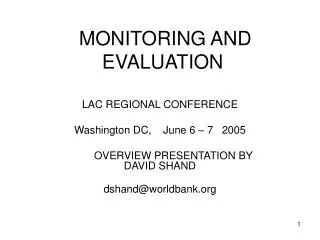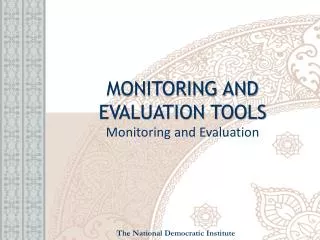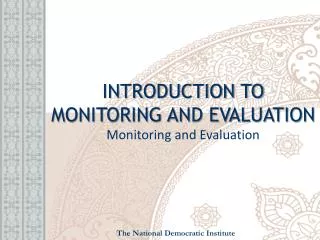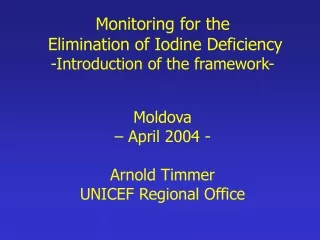Monitoring and Evaluation
Monitoring and Evaluation. Dr. Raghu Bista Anil Kumar Gupta. Outline. Basics of M&E framework Result orientation in practice: Monitoring tools, techniques and issues in selected projects. Implementation of Project/Programs.
Share Presentation
Embed Code
Link
Download Presentation

adamscynthia + Follow
Download Presentation
Monitoring and Evaluation
An Image/Link below is provided (as is) to download presentation Download Policy: Content on the Website is provided to you AS IS for your information and personal use and may not be sold / licensed / shared on other websites without getting consent from its author. Content is provided to you AS IS for your information and personal use only. Download presentation by click this link. While downloading, if for some reason you are not able to download a presentation, the publisher may have deleted the file from their server. During download, if you can't get a presentation, the file might be deleted by the publisher.
Presentation Transcript
- Monitoring and Evaluation Dr. Raghu Bista Anil Kumar Gupta
- Outline • Basics of M&E framework • Result orientation in practice: Monitoring tools, techniques and issues in selected projects
- Implementation of Project/Programs • Once preparation is completed, finance is assured and design is finalized, project/program is forwarded for implementation. • During implementation phase, Project/program is put into action. Roads will be contracted and built, project activities will be started and completed, project output will be produced. So this is the investment phase of the project. Here, inputs are converted into outputs
- Outputs of Project/Programs Implementation • The output of the implementation phase is the new road, new hydropower capacity, new bridge, new hospital department, new irrigation system, trained manpower, enhanced capacity, new product etc.
- Project Implementation • To create expected outputs, projects are divided into work packages and activities, activity time and activity cost are estimated, time schedules are prepared. Likewise budget, resources and procurement plan are efficiently utilized
- Project Control • During project/program implementation, control is management function to corrective action to address gap between and actual and planned performance. Clearly, the need to exert proper control mandates the need to monitor the proper activities and elements of the project
- The Project Control Cycle 1. Setting a Goal 4. Taking Corrective Actions 2. Measuring Progress 3. Comparing Actual With Planned
- Monitoring • “Monitoring is the collection, recording, and reporting of project information that is of importance to the project manager and other relevant stakeholders” (Mantel, Meridith, Shafer, Sutton & Gopalan, 2005). • Monitoring is a continuous function that uses systematic collection of data on specified indicators to provide management and the main stakeholders of an ongoing development intervention with indications of the extent of progress and achievement of objectives and progress in the use of allocated funds. (World Bank, 2011)
- Purpose of Monitoring • To indicate at the earliest instance any shortcomings with regard to achieving intended objectives so that measures can be undertaken in good time • To monitor the development of the project as a whole, and its component projects, in relation to changes in the context and circumstances of their implementation. • To implement a rapid problem identification system as well as a system for internal communications to the various stakeholders.
- Purpose of Monitoring Cont.. • To provide forecasts on cost, • To forecast resources and schedule • To facilitate evaluation process during and after activities, through the definition of specific indicators.
- Process of Monitoring • Identification of Indicators • Collection of information • Analysis of information • Use of information for Action
- Work Schedule and Monitoring
- Project S-Curve as Tool for Cost Monitoring • Project S curve consists of presenting costs against time for both budgeted and actual expenditure.
- 60 40 Cumulative Budgeted Cost 20 Cumulative Actual Cost 10 15 20 25 30 35 40 45 50 5 Elapsed Time (in weeks) The Project S-Curve Cumulative Cost ($ in thousands) $20,000 Negative Var
- Evaluation • Evaluation can be defined as a process by which general judgments about quality, goal attainment, project/program effectiveness, impact and costs can be determined. It can therefore be conceptualized as a review of the whole project/program in order to assess its overall value and effects. • Evaluation is a systematic and purposeful undertaking carried out by internal or external evaluators to appraise relevance, effectiveness, efficiency, impacts as well as sustainability generated by the policies, plans, programmes, and projects under/after implementation. (National Planning Commission, 2013)
- Evaluation at Different Level • Evaluation is also classified by subject such as project level, program level, sector Level, policy level.
- Evaluation Type • Ex-ante Evaluation • Mid Term Evaluation • Completion Evaluation • Ex-post Evaluation (Impact Evaluation)
- M & E During Programme/Project Period (National Planning Commission , 2013)
- Type of Evaluation Start of Implementation Completion of Implementation 2. Implementation of projects 4. 1. 3.
- Ideal situation-M& E Complementary Monitoring Evaluation
- Difference Between M & E • Evaluation is assessing the entire project cycle. • Evaluation looks for lessons to be learned from both success and lack of success, and also looks for best practices which can be applied elsewhere. • It is concerned with the assessment of progress against predetermined goals, outcomes and their effects and impacts on stakeholders. • It is generally conducted by an independent outsider • Monitoring is a continuing function that takes place throughout the implementation of a project/programme • It focuses on the implementation of the project comparing what is delivered with what is planned • It is directly related with inputs, processes and outputs. • It is generally conducted by the implementing agency.
- Result based M& E Video
- Result Based Management • Result based management is perspective that focus on achievement of development results. • It is a management strategy that focuses on the processes, products and services contributing to the achievement of development results (NPC, 2013)
- How the Results Come • Once a project is designed and implemented, it will produce outputs (For example 25 trained math teachers) • The trained math teachers will use improved methods to teach, the result will be increased math solving competency of students • In exam, number of students to pass exam will be increased with better marks as ultimate results and will be able to get scholarship
- Results Chain Impacts Activities Outputs Outcomes Inputs

MONITORING AND EVALUATION
Challenges. Accuracy , completed ( HZ and by Indicators)The level of the use of data( HZ, Partner, COP, USAID)Indicator, Targeted population, Mean of verification , Performance Target. Evidence based M
488 views • 15 slides

MONITORING AND EVALUATION
MONITORING AND EVALUATION . LAC REGIONAL CONFERENCE Washington DC, June 6 – 7 2005 OVERVIEW PRESENTATION BY DAVID SHAND dshand@worldbank.org. PART 1 GENERAL ISSUES IN EVALUATION . INTRODUCTION
498 views • 33 slides

Monitoring and Evaluation
Monitoring and Evaluation. Monitoring-systematic collection of data Evaluation-use of data to make decisions regarding restoration or success of restoration -use ecological data from ecological studies of ecosystems as reference sites for comparison to restored sites. Adaptive Management.
725 views • 33 slides

Monitoring and Evaluation
Monitoring and Evaluation. Heritage Tourism Project Key Issues as envisaged by Cadw Howard James. Key requirements. Visitor numbers each year Two visitor surveys to determine type and therefore value of visitor Any other key outputs/ outcomes relating to a particular project. Why M&E ? .
257 views • 9 slides

Monitoring and Evaluation
Module 11. Monitoring and Evaluation. Basic M&E Requirements of a Joint Programme. Every JP Document should have an M&E Framework and an M&E Plan. It should be derived from the UNDAF or Consolidated Appeal Process M&E Framework and Plan.
473 views • 10 slides

Monitoring and Evaluation
Monitoring and Evaluation. HRBA/RBM UNDAF/One Program M&E JP M&E Monitoring Progress, Processes and Results Reporting Progress and Results Facilitating Reviews and Evaluations Planning for the Next program cycle Situation Analyses+ Preparing LogFrames+ M&E Frameworks and M&E Plans.
601 views • 9 slides

Monitoring and Evaluation
Monitoring and Evaluation. Nidhi Khattri WBIEG December 5, 2006. Capacity Building and Evaluation: Some Questions. If you don't know where you're going, you'll probably end up somewhere else." Yogi Berra Capacity for what? Capacity for whom? What outcomes do we expect? By when?
381 views • 5 slides

Monitoring and Evaluation
Monitoring and Evaluation. Outline. Indicators, progress and targets (outputs level) Year 1, and year 2 countries Yellow colour to flag areas for improvement. Policy, political & social environment. Output 1. National comprehensive communication and advocacy strategy developed (1)
580 views • 17 slides

Monitoring and Evaluation
Monitoring and Evaluation. Zoe Khor and Helen Sender CDF TRIF away day July 8 th 2010.
382 views • 13 slides

Monitoring and Evaluation
Monitoring and Evaluation. Jela Tvrdonova Cordoba, 2010. Effects of the strategy in the development trend context. No can solve all problems of particular area, country or region. But targets in certain time only some areas of life
518 views • 25 slides

Monitoring and Evaluation
Monitoring and Evaluation. Prof. Thomas Tufte , PhD Roskilde University Presentation given at MIH, University of Copenhagen, 19 February 2013. What is Monitoring and Evaluation about?. Why monitor and evaluate? Who decides what to monitor? The people, the org/consultant, the donor
423 views • 8 slides

MONITORING AND EVALUATION TOOLS Monitoring and Evaluation
MONITORING AND EVALUATION TOOLS Monitoring and Evaluation. The National Democratic Institute. Introductions/ Ground rules. Introductions Ground Rules Ice Breaker Exercise. Photo: Sanja Gjenero, RGBstock.com. Monitoring and Evaluation (M&E) Tools Objectives.
3.52k views • 39 slides

Monitoring and evaluation
PSYCHOSOCIAL INTERVENTIONS MONITORING AND EVALUATION. Monitoring and evaluation. PSYCHOSOCIAL INTERVENTIONS MONITORING AND EVALUATION. Focus of this workshop session. Psychosocial interventions. Monitoring. Evaluation.
806 views • 37 slides

INTRODUCTION TO MONITORING AND EVALUATION Monitoring and Evaluation
INTRODUCTION TO MONITORING AND EVALUATION Monitoring and Evaluation. The National Democratic Institute. Introductions/ Ground rules. Introductions Ground Rules Ice Breaker Exercise. Introduction to Monitoring and Evaluation Objectives.
1.39k views • 33 slides

Monitoring and Evaluation
Interim. Draft Module 11 - September 2008. Monitoring and Evaluation. Project Partners. Collaborative project. Funded by the United States Agency for International Development (USAID). Module Overview. Monitoring & Evaluation (M&E) framework and components Records, registers and reports
1.09k views • 43 slides

Monitoring and Evaluation
Biocontrol of Parthenium. Monitoring and Evaluation. K. Dhileepan Segun Osunkoya Rachel McFadyen. Invasive Plant Science Biosecurity Queensland Department of Agriculture, Fisheries & Forestry Ecosciences Precinct Brisbane, Australia. Biological control. Initiated in 1974
314 views • 19 slides

MONITORING AND EVALUATION TOOLS Monitoring and Evaluation
MONITORING AND EVALUATION TOOLS Monitoring and Evaluation. The National Democratic Institute. Introductions/ Ground rules. Introductions Ground Rules Ice Breaker Exercise. Photo: Sanja Gjenero, RGBstock.com. Monitoring and Evaluation (M&E) Tools Objectives.
923 views • 39 slides

Monitoring and Evaluation
Monitoring and Evaluation. West Virginia’s Review of Funded Projects, Services and Activities. Focus on the “3 R’s”. Recovery
234 views • 12 slides

Monitoring and Evaluation
Monitoring and Evaluation. Prof. Thomas Tufte , PhD Roskilde University Presentation given at MIH, University of Copenhagen, 19 February 2013. What is Monitoring and Evaluation about?. Why monitor and evaluate? Who decides what to monitor? The people, the org/consultant, the donor
289 views • 8 slides

Monitoring and evaluation:
Monitoring for the Elimination of Iodine Deficiency -Introduction of the framework- Moldova – April 2004 - Arnold Timmer UNICEF Regional Office. Monitoring and evaluation:. The reasons for monitoring The type and quality of information to collect Data collection methods
378 views • 28 slides

INTRODUCTION TO MONITORING AND EVALUATION Monitoring and Evaluation
INTRODUCTION TO MONITORING AND EVALUATION Monitoring and Evaluation. The National Democratic Institute. Introductions/ Ground rules. Introductions Ground Rules Ice Breaker Exercise. Introduction to Monitoring and Evaluation Objectives.
1.09k views • 33 slides























